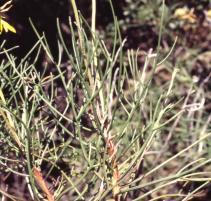Euryops speciosissimus
Euryops speciosissimus DC.
Family: Asteraceae
Common names: giant resinbush, Clanwilliam euryops (Eng.); pronkharpuisbos, grootharpuisbos (Afr.)
Introduction
The name of this species indicates that the plant must be something special. The Latin word speciosissimus means spectacular or the showiest of all. When seen in full flower around Clanwilliam the breathtaking beauty of this species is very obvious.

Description
Description
Tall vigorous shrub, 0.45-2.5 m high, strongly resiniferous and smooth. Branches leafy in upper part, bare below. Leaves (40-60)-200 mm long, needle-like with up to 7 branches to each side of the central nerve.

Individual flower heads are borne on stout stems 80-400 mm long. Outer bracts of flower heads are fused into a deep cup which is inflated in the lower half and narrowing into a beak towards the open end, 8-15 mm high. Flower heads are large, up to 90 mm in diameter, with 16-35 ray florets, the rays 17-45 mm long and a rich yellow colour. Central disc florets are numerous (100-400). Seeds are 6-7 mm long and without hairs.
Flowering is mainly from August to November but may start in July and continue into January.
Conservation Status
Status
Although this species is probably not threatened it is heartbreaking to see large areas of its habitat taken over by agriculture.
Distribution and habitat
Distribution description
Grows in dry fynbos on rocky sandstone slopes and in valleys in the Vanrhynsdorp, Clanwilliam, Piketberg and Tulbagh districts. It can be found at altitudes ranging from 150-850 m.
Ecology
Ecology
Flowers are visited by general pollinators such as bees, beetles and flies. The cup-shaped bracts of the flowers provide a protected environment for insects to lay their eggs and the flower heads are therefore often parasitized.

Uses
Use
Old flowering stems and bracts are woody and can be used very effectively in the dried-flower industry. The horticultural use of this species is recognized, but should be more widely promoted.
Growing Euryops speciosissimus
Grow
E. pectinatus (grey euryops, golden daisy bush), E.chrysanthemoides, E. virgineus (honey euryops) and E. speciosissimus (Clanwilliam euryops) are probably the Euryops species that are best known to gardeners. Of these the Clanwilliam euryops has the largest flowers. It is fast growing and can be planted singly or in groups. Older plants become straggly and are bare at the base. This can be concealed by planting it behind lower-growing plants and by pruning the shrubs after flowering. As it is a winter-rainfall species, plants should be watered well in winter to produce a spectacular show in spring and summer, but be sure to provide good drainage and a sunny warm spot in the garden for this plant. Propagate from seed or from cuttings.
References
- JOFFE, P. 1993. The Gardener's guide to South African plants. Delos, Cape Town.
- NORDENSTAM, B. 1968. The genus Euryops. Part I. Taxonomy. Opera Botanica 20. C.W.K. Gleerup, Lund, Sweden.
- NORDENSTAM, B. 1969. Phytogeography of the genus Euryops (Compositae). Opera Botanica 23. C.W.K. Gleerup, Lund, Sweden.
Credits
Marinda Koekemoer
National Herbarium Pretoria
January 2005
Plant Attributes:
Plant Type: Shrub
SA Distribution: Northern Cape, Western Cape
Soil type:
Flowering season: Spring, Early Summer, Winter
PH:
Flower colour: Yellow
Aspect: Full Sun
Gardening skill: Average
Special Features:
Horticultural zones








Rate this article
Article well written and informative
Rate this plant
Is this an interesting plant?
Login to add your Comment
Back to topNot registered yet? Click here to register.